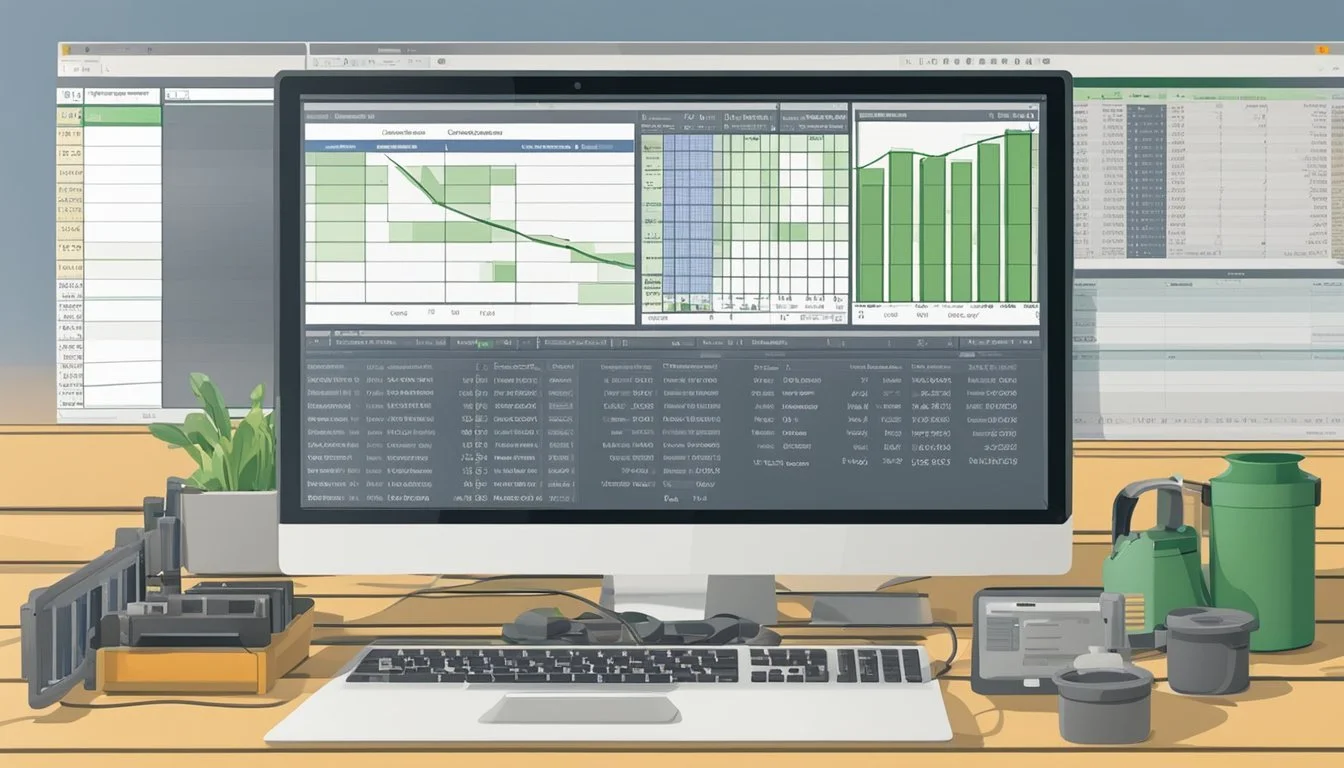Homestead Record Keeping and Data Analysis
Optimizing Your Self-Sufficient Lifestyle
Effective homestead management relies on meticulous record keeping and data analysis. Homesteaders invest considerable effort in maintaining a diverse array of records that track the progress and productivity of their land, livestock, gardening endeavors, financials, and various projects. By compiling detailed logs, homesteaders can monitor the health and yields of their crops and animals, assess the success of their farming strategies, and allocate resources more efficiently.
Data analysis enables homesteading individuals to make informed decisions based on historical records, seasonal variations, and financial outcomes. This can lead to improved yields, better financial planning, and the mitigation of potential risks. For instance, by analyzing past harvest data, a homesteader can predict future crop performance and plan crop rotations accordingly. Similarly, tracking expenses and income facilitates a more strategic approach to managing the homestead's budget and investments.
Moreover, advancements in digital technology have opened up new avenues for record keeping and data analysis. Digital tools and apps allow for more streamlined and accessible data management, enabling homesteaders to keep up-to-date records and perform analyses with greater ease. This evolution from traditional paper-based systems to modern digital solutions has made it possible for even small-scale homesteads to engage in sophisticated data practices once reserved for larger agricultural operations.
Understanding Homestead Record Keeping
In the realm of homesteading, meticulous record-keeping is an indispensable tool for tracking growth, managing expenses, and evaluating the overall success of the endeavors, whether in the garden, with livestock, or during harvesting seasons.
The Importance of Record Keeping
Effective record-keeping is crucial for any homestead, serving as a foundation for informed decision-making. Complete and accurate records help homesteaders understand the health and productivity of their garden and livestock, manage expenses, and ultimately measure success. This data is vital for assessing efficiency, planning future projects, and meeting both short and long-term goals.
Types of Homestead Records
Homestead records can vary widely, encompassing aspects such as:
Garden: Data on planting dates, companion planting strategies, and harvesting yields.
Livestock: Health records, breeding schedules, and production data.
Expenses: Receipts and invoices for supplies, feed, and equipment.
The comprehensiveness of these records is tied directly to their ability to provide meaningful information for analysis and future planning.
Choosing a Record-Keeping System
A well-chosen record-keeping system is imperative for efficiently managing homestead records. Options range from traditional paper-based solutions, like a binder or a simple notebook, to more sophisticated technology such as:
Spreadsheets: Excel or Google Sheets for detailed analysis.
Databases: For larger homesteads that require robust data management.
Apps & Digital Records: Mobile notes app or specialized homesteading apps that offer convenience and accessibility.
Each system has its own merits, and the selection should align with the homesteader's comfort with technology, the size and complexity of the homestead, and the specific types of records maintained. Whether it's jotting down information in a notes app or compiling data in a comprehensive spreadsheet, the key is to ensure that the system chosen is one that will be consistently used and is scalable to meet the growing needs of the homestead.
Setting Up Your Record Keeping System
A proper system for record keeping is the backbone of efficient homestead management. It aids in tracking progress, planning for the future, and making informed decisions.
Digital vs. Paper Records
The choice between digital and paper records comes down to personal preference and the technology available. Digital records offer convenience, are easily backed up, and can be accessed on your phone or computer. In contrast, paper records involve physical binders or notebooks, which some may find more tangible and reliable. Digitalizing records using a homestead management planner allows for editing and adding data with ease; however, a paper-based system may safeguard against data loss due to technological failures.
Creating a Homestead Management Binder
A Homestead Management Binder is a centralized resource that organizes all aspects of homestead planning and record keeping. To design an effective binder, begin by including sections like a daily planner and a monthly calendar. Essential categories might involve:
Livestock care schedules
Garden planting and harvesting logs
Financial records and receipts
The binder's design should reflect the specific needs of your homestead, which may require customizable templates as found in resources like Our Homestead Guide.
Using Homesteading Apps
For those comfortable with technology, a variety of homesteading apps like SmartSteader can enhance record management. These apps provide features for tracking gardening activities, livestock, expenses, and revenues directly from your phone. Choosing the right app involves assessing how it integrates with your homesteading operations and if it offers desired functionalities. Here's an example of app features:
Gardening Tracker: Benefit - Keeps records of planting and harvesting dates
Financial Overview: Benefit - Monitors expense and income
Livestock Manager: Benefit - Manages health and breeding records
Homesteading apps streamline data analysis and can offer insights into trends and areas for improvement on the homestead.
Integrating Technology with Homesteading
In an era where technology pervades every aspect of life, homesteaders are harnessing digital tools to enhance productivity and streamline their record-keeping processes. From gardening apps to comprehensive databases, these tools function as a secret weapon in the diligent management of daily tasks.
Mobile and Web Applications
Homesteaders now have access to a plethora of mobile and web apps designed to simplify the management of their endeavors. The Smartsteader app acts as a digital daily planner, allowing for meticulous monitoring of planting schedules, livestock feed, and other critical tasks. Another boon for gardeners is the range of available gardening apps. These applications help track planting, harvesting, watering schedules, and even pest control measures, thereby elevating the precision of homesteading today.
The Use of Spreadsheets and Databases
Spreadsheets and databases offer a powerful method to digitize and organize homesteading information. A well-structured spreadsheet can replace piles of cumbersome papers, enabling homesteaders to track everything from yield rates to financial expenditures with ease. Databases take this a step further by offering more complex data analysis tools, creating opportunities for long-term forecasting and more informed decision-making.
Digitization of Records
Transitioning to digital records from traditional pen and paper provides a multifaceted advantage. The digitization process not only secures data against physical loss but also makes retrieval and analysis straightforward and rapid. A simple notes app, frequently overlooked, can prove instrumental in recording fleeting thoughts or observations that may later provide insightful data points. The systematic digitization of records ensures that no valuable information slips through the cracks, cementing technology's role as an integral aspect of modern homesteading.
Daily and Seasonal Record Keeping
Record keeping is a critical part of managing a homestead effectively. Carefully logged daily activities and observations help in making informed decisions, ensuring a sustainable practice throughout the changing seasons.
Daily Livestock Management
An organized approach to daily livestock management ensures optimal animal health and productivity. Records should include the date, time, and details of feeding, with specific notes on types of feed and amounts given to each species. Monitoring health is crucial; thus, any signs of illness or changes in behavior should be documented promptly. Data on milk production and egg counts contribute to performance analysis over time, allowing adjustments in care and feeding.
Garden and Crop Maintenance Logs
The garden requires regular monitoring and maintenance to maximize crop yield. A garden and crop maintenance log should include watering schedules, fertilizer applications, and harvest times. Maintaining a calendar of seasonal activities, like planting or pruning, aids in planning for successive years. Tracking garden expenses helps in budgeting and evaluating the cost-effectiveness of different gardening practices.
Tracking Expenses and Productivity
Efficient homestead management involves meticulous tracking of expenses and productivity. A ledger or spreadsheet can be used to record all expenses—from livestock purchases to equipment maintenance. These financial records are essential for creating a budget and forecasting costs for upcoming seasons. Comparing productivity metrics across different areas of the homestead, from livestock to crops, provides insight into the most and least profitable ventures, guiding future investments and efforts.
Planning for Future Homestead Goals
Effective homestead management hinges on meticulous record keeping and informed data analysis. These practices empower homesteaders to set focused goals and measure their success through quantifiable benchmarks, which in turn drive production and operational improvements.
Setting Goals and Benchmarks
In the realm of homesteading, defining clear objectives is pivotal. Goals may encompass a broad spectrum, from increasing crop yields to achieving sustainability milestones. For each goal, homesteaders should establish precise benchmarks. These metrics serve as indicators of progress and help homesteaders maintain a trajectory towards their desired outcomes. Additionally, maintaining detailed production records fosters an environment conducive to planning and growth.
Improving Homestead Production
Once goals and benchmarks are in place, attention shifts to enhancing production. Homesteaders can perform data analysis on past production records to identify trends and areas for improvements. Are certain crops yielding less than anticipated? Can livestock feed efficiencies be increased? Answering these questions with data informs strategic decisions that drive productivity upward.
Expanding Homestead Operations
For many, success in homesteading involves growth—be it scaling up operations or diversifying endeavors. Expansion should be guided by a strategic planning process rooted in reliable record keeping. This involves assessing current capabilities against growth targets, determining resource requirements, and setting systematically planned stages for development. Thoughtful planning reduces risk and ensures that each step towards expansion is grounded in solid data and achievable milestones.
Specialized Record Keeping
Effective management of a homestead involves meticulous record keeping, particularly regarding breeding, health, and agricultural performance. Specialized record keeping enables homesteaders to track detailed information that can inform better decision-making for improved efficiency and productivity.
Breeding and Kidding Records
Breeding and Kidding Records involve the systematic tracking of livestock reproduction cycles. Key data points include breeding dates, sire and dam information, and expected kidding dates. This allows for the anticipation of herd growth and the planning of resources accordingly.
Example Breeding Record:
Date: 02/04, Sire ID: B001, Dam ID: D053, Expected Kidding Date: 06/05
Health and Vaccination Logs
Health and Vaccination Logs are critical for maintaining livestock wellbeing. They should detail each animal's vaccination schedule, health check results, and treatments administered. Consistent logging allows for quick identification of health patterns and proactive management of vaccinations and treatments.
Vaccination Log Example:
Livestock ID: L090
Vaccine: Tetanus
Date Administered: 04/03
Next Due Date: 04/10
Agricultural Project Analysis
Agricultural Project Analysis utilizes data analysis to evaluate the success of various agricultural projects, such as crop rotation and composting strategies. Detailed records on crop yields, inputs like compost or fertilizers, and environmental conditions help draw conclusions on agricultural practices' effectiveness.
For crop rotation analysis, data on yields might be organised as follows:
Crop Rotation Yield Analysis:
Year: 2023, Field ID: F1, Crop Planted: Corn, Yield (bushels): 150
Year: 2024, Field ID: F1, Crop Planted: Soybeans, Yield (bushels): 130
Careful data recording and analysis in specialized areas such as breeding and kidding, health and vaccination, and agricultural project analysis are foundational to the sustainable management and continuous improvement on a homestead.
Homesteading and Legal Compliance
In the realm of homesteading, adhering to legal requirements is as critical as the agricultural planning and livestock management practices. Compliance ensures that homesteaders can legally protect their investments and lifestyle.
Understanding the Homestead Act
The Homestead Act of 1862 was a significant piece of legislation that affected American land ownership. It allowed any qualified individual—including freed slaves, women, and immigrants—to claim 160 acres of public land. To gain ownership, claimants had to prove they had improved the land, often through agriculture, and built a dwelling. Records of these claims are held at the National Archives, detailing the historical progress and the identification of claimants, which sometimes included military service or a widow's claim.
Keeping Track of Legal Documentation
For contemporary homesteaders, maintaining thorough records is vital for operational success and adherence to laws. Crucial documents include proof of ownership, agricultural plans, details of livestock, and evidence of sustainable management of resources like trees and water. It is also important to keep records of any homestead improvements, as they may be necessary for tax purposes or when seeking certain types of agricultural assistance or funding.
Zoning and Regulatory Records
Homesteaders must navigate the complex web of zoning laws and regulations, which can vary greatly from one locality to another. These laws affect what types of structures can be built, what agriculture practices can be undertaken, and the types of livestock that can be kept. Availability of such records from local land offices or planning departments is essential for legal compliance. Regular reviews of these records help prevent costly and time-consuming disputes or violations.
Homesteaders who meticulously track regulatory updates and document their compliance are better positioned to advocate for their interests and adjust their operations to remain in legal standing.
Supplemental Homestead Activities
In managing a homestead, it's crucial to maintain comprehensive records that extend beyond typical day-to-day operations. These activities support the primary goals of the homestead, providing a structure for expansion and education.
Homestead Mapping and Land Design
Homestead mapping serves as a foundational tool in strategic land use, helping to maximize productivity. By integrating detailed land planning with the design elements, homestead owners can clearly visualize their space and allocate resources effectively. For instance, the placement of crops in relation to water sources or the orientation of livestock shelters can be planned to optimize land use and animal welfare.
Land Offices: Consultation with local land offices may offer valuable information on zoning restrictions, which can influence the design and mapping of the property.
Homeschooling and Educational Records
Many homestead families incorporate homeschooling into their lifestyle. Keeping meticulous educational records ensures compliance with local legal requirements and helps track a child's progress. It can include lesson plans, attendance records, and achievements.
Curricula and educational milestones
Attendance and progress tracking logs
Diversification with Livestock and Crops
Diversification is key to a resilient homestead. By maintaining a variety of livestock and crops, homesteaders can mitigate risks and improve food security. Keeping accurate records of animal breeds, plant varieties, harvest yields, and breeding patterns is essential for analyzing the success of diversification efforts.
Diversification Records:
Livestock: species, breeds, health records
Crops: types, planting dates, harvest volumes







